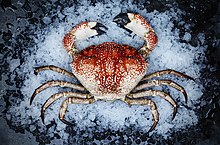Tasmanian giant crab
| Tasmanian giant crab | |
|---|---|

| |
| Scientific classification | |
| Domain: | Eukaryota |
| Kingdom: | Animalia |
| Phylum: | Arthropoda |
| Class: | Malacostraca |
| Order: | Decapoda |
| Suborder: | Pleocyemata |
| Infraorder: | Brachyura |
| Family: | Menippidae |
| Genus: | Pseudocarcinus |
| Species: | P. gigas
|
| Binomial name | |
| Pseudocarcinus gigas (Lamarck, 1818)
| |
| Synonyms [1] | |
|
Cancer gigas Lamarck, 1818 | |
The Tasmanian giant crab (Pseudocarcinus gigas), also known as the giant deepwater crab, giant southern crab, queen crab, or bullcrab, is a very large species of crab that resides on rocky and muddy bottoms in the oceans off Southern Australia.[2][3] It is the only extant species in the genus Pseudocarcinus.[4]
Habitat
[edit]The Tasmanian giant crab lives on rocky and muddy bottoms in the oceans off Southern Australia on the edge of the continental shelf at depths of 20–820 metres (66–2,690 ft).[2][3] It is most abundant at 110–180 metres (360–590 ft) in the summer and 190–400 metres (620–1,310 ft) in the winter.[3] The seasonal movements generally follow temperature as it prefers 12–14 °C (54–57 °F).[3] The full temperature range where the species can be seen appears to be 10–18 °C (50–64 °F).[5]
Description
[edit]

The Tasmanian giant crab is one of the largest crabs in the world, reaching a mass of 17.6 kg (39 lb) and a carapace width of up to 46 cm (18 in).[6] Among crabs, only the Japanese spider crab (Macrocheira kaempferi) can weigh more.[5] Male Tasmanian giant crabs reach more than twice the size of females,[7] which do not exceed 7 kg (15 lb).[6] Males have one normal-sized and one oversized claw (which can be longer than the carapace width[5]), while both claws are normal-sized in females.[6] This crab is mainly whitish-yellow below and red above; the tips of the claws are black.[8] Small individuals are yellowish-and-red spotted above.[5]
Behaviour
[edit]The Tasmanian giant crab feeds on carrion and slow-moving species, including gastropods, crustaceans (anomura and brachyura) and starfish.[3][7] Cannibalism also occurs.[3] They breed in June and July, and the female carries the 0.5–2 million eggs for about four months.[7] After hatching, the planktonic larvae float with the current for about two months before settling on the bottom.[5] The species is long-lived and slow-growing; juveniles moult their carapace every three-four years and adult females about once every nine years.[5][6] This greatly limits the breeding frequency, as mating is only possible in the period immediately after the old carapace has been shed, and the new is still soft.[6]
Fishery
[edit]The Tasmanian giant crab has been commercially fished in Tasmanian waters since 1992 and a minimum size was established in Australia in 1993.[7] Fishing is typically by pots in water deeper than 140 m (460 ft).[6] Following concerns surrounding the sustainability of catch numbers, the total allowable catch was adjusted for 2024/25 quota year to 20.7 tonnes (46,000 lb).[9] valued at about A$2 million.[9] The Tasmanian giant crab is very long-lived and slow-growing, making it vulnerable to overfishing.[7] Before export, they are sometimes kept alive in tanks with water that is 10–14 °C (50–57 °F).[3]
References
[edit]- ^ Peter Davie (2010). "Pseudocarcinus gigas (Lamarck, 1818)". World Register of Marine Species. Retrieved October 9, 2010.
- ^ a b Palomares ML, Pauly D, eds. (2013). "Pseudocarcinus gigas" in SeaLifeBase. December 2013 version.
- ^ a b c d e f g Levings, A.H. & P.C. Gill (2010). Seasonal Winds Drive Water Temperature Cycle and Migration Patterns of Southern Australian Giant Crab Pseudocarcinus gigas. In: G.H. Kruse, G.L. Eckert, R.J. Foy, R.N. Lipcius, B. Sainte-Marie, D.L. Stram, & D. Woodby (eds.), Biology and Management of Exploited Crab Populations under Climate Change. ISBN 978-1-56612-154-5. doi:10.4027/bmecpcc.2010.09
- ^ P. K. L. Ng, D. Guinot & P. J. F. Davie (2008). "Systema Brachyurorum: Part I. An annotated checklist of extant Brachyuran crabs of the world" (PDF). Raffles Bulletin of Zoology. 17: 1–286.
- ^ a b c d e f Poore, G.C.B. (2004). Marine Decapod Crustacea of Southern Australia: A Guide to Identification. CSIRO Publishing. p. 445. ISBN 0-643-06906-2.
- ^ a b c d e f Tasmanian Museum and Art Gallery (2013-02-12). "Giant crab – a goliath amongst crustaceans". Shaping Tasmania: a journey in 100 objects. Department of Economic Development, Tourism and the Arts. Retrieved 2024-08-13.
- ^ a b c d e D. R. Currie & T. M. Ward (2009). South Australian Giant Crab (Pseudocarcinus gigas) Fishery (PDF). South Australian Research and Development Institute. Fishery Assessment Report for PIRSA. Retrieved 9 December 2013.
- ^ N. Coleman (1991). Encyclopedia of Marine Animals. Blandford, Villiers House. p. 107. ISBN 0-7137-2289-4.
- ^ a b "Giant crab fishery". Department of Natural Resources and Environment Tasmania. Retrieved 2024-08-13.
External links
[edit] Media related to Pseudocarcinus gigas at Wikimedia Commons
Media related to Pseudocarcinus gigas at Wikimedia Commons
